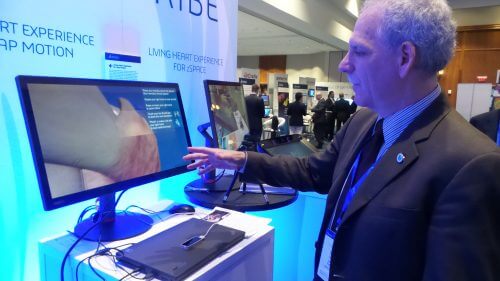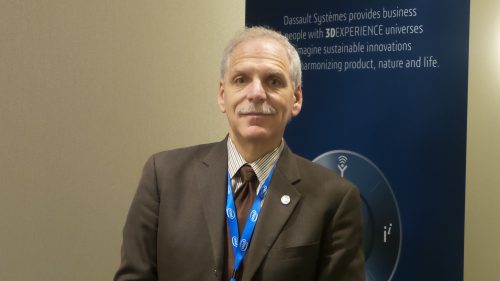Dr. Steven Levin, chief strategy officer at Dassault Systèmes, and responsible for the strategy and vision of its simulation system – SIMULIA , updates us on the progress in the human heart imaging project, which is being developed in collaboration with pharmaceutical and medical device companies and academia

About six months ago we spoke with Dr. Steven Levin, chief strategy officer at Dassault Systèmes, and responsible for the strategy and vision of its simulation system - SIMULIA, which demonstrated at the Israel Cardiologists Association conference the human heart project, - The Living Heart Project, which Dassault Systèmes leads with more than 40 academic, scientific and industrial bodies from around the world. Now, in an interview with the scientist website that took place during the Science in the Age of Experience conference in Boston, Levin informs that great progress has been made, even if the goal is still far away - of adapting the simulation to the patient's heart. Another update is that not only the mechanical and electrical aspects of the heart are integrated in the simulation, but also biological aspects, thanks to BIOVIA's joining the project - a division based on a recently acquired company of the same name, which also enables drug trials on the recommended heart.
"The community participating in the human heart project is multidisciplinary, and includes academic researchers, active cardiologists, industrial partners, as well as regulatory bodies, the most prominent of which is the FDA. "We are making progress on the road map for the development of the technology."
"Today we enable a common language, where the same model of the heart is used for the various applications that each community is interested in - diagnosis, analysis, etc. For example, a surgeon will be able to perform a simulation to see what is expected to happen to a patient two or three years in the future if he performs a certain surgical procedure, and thus he can choose the surgical procedure that will make the patient's life easier over time."

"One of the bases of the project is the translation of the terms into a language that the patient can understand. Cardiologists are very interested in the project, because they have difficulty explaining to patients what his condition is. For example, we can show the patient a simulation of the operation of his heart by inserting the EKG data into the simulation, and viewing it in XNUMXD through glasses and on his phone."
"In Israel, Medinol and Tel Aviv University are partners in the program. Medinol is a company that develops and manufactures medical devices, mainly stents, and they use our software to improve the design to try the devices before they go to actual trials, thus increasing the reliability of the stent and strengthening its durability through an experiment on a representative heart model. Just like car companies crash thousands of cars in a realistic simulation environment, Madinol can also show how the supporter will behave inside a real heart, and speed up the development process, as well as promote the device's regulatory process."
"In the first step, it will be possible to choose different shapes of hearts with different defects, and conduct a simulation showing a heart that is as similar as possible. In the future, the intention is to symbolize the specific heart of the patient."
"We have made a lot of progress in this direction. There are two problems with creating a personalized heart, one is the size and shape - every heart is slightly different, and as you get older and when you have heart disease, it changes. The muscles and the electrical process should have the same physiological behavior as the patient's real heart. We have tools that allow us to quickly switch from MRI or CT imaging to reconstruct the geometry of the heart. We run workshops, including one that will be held in Israel in the fall, when people can come, receive MRI data and produce an individual heart in the simulation in the right shape and size."
"The second problem is the need to model the state of the disease. If so far we have worked with an ideal heart, which of course has no problems that need to be solved, we started working with Intel and MIT (Intel donated supercomputing time) on the simulation of change processes that go through the heart during illness; For example muscle weakness. We have created a database of features, which makes it possible to extract from the database the model that represents the specific heart."
"We have made a lot of progress. We are not done, but we have already been able to identify some disease states. Our work was presented shortly before the conference in Washington at the same time as the FDA meeting. The meeting was attended by 75 people from the partner bodies in the project, including an MIT representative and 15 representatives from the various communities."
Extending the range
"Our model has so far focused on a simulator for simulating medical devices, because SIMULIA mainly focuses on electromechanics, so we focus on devices such as stents, valves and pacemakers. Together with our colleagues from BIOVIA we began to examine the interaction of the drugs with the heart. The idea is to build a common platform based on the 3DEXPERIENCE platform of Dassault Systèmes, to share the data between the communities, which will also be expanded to include pharmaceutical companies, so that we can use the same database to try devices and drugs, and in particular a combination of them."
"Another field that is integrated into the simulation is the genomic aspect. Understanding the local uniqueness and representing communities all over the world will add more information about the heart."
